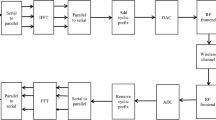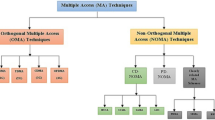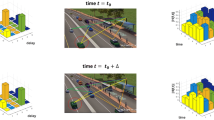Abstract
Orthogonal frequency division multiplexing (OFDM) technique, when used in wireless environments, is known to be robust against frequency selective fading. However, when the channel shows time selective fading, rapid variations destroy the subcarrier orthogonality and introduce inter-carrier interference (ICI). The use of ICI mitigation schemes requires the availability of channel state information (CSI) at the receiver, which is a non-trivial task in fast fading systems. In our work, we have addressed the problem of estimation of rapidly varying channels for OFDM systems. The channel is modeled using complex exponentials as basis functions and the estimation process makes use of the cyclic prefix (CP) part available in OFDM symbols as training. The system is viewed as a state space model and Kalman filter is employed to estimate the channel. Following this, a time domain ICI mitigation filter that maximizes the received SINR (signal to interference plus noise ratio) is employed for equalization. This method performs considerably well in terms of MSE as well as BER at very high Doppler spreads.
Similar content being viewed by others
References
van de Beek, J. J., Edfors, O., Sandell, M., Wilson, S. K., & Borjesson, P. O. (1995). On channel estimation in OFDM systems. In Proc. IEEE 45th Veh. Tech. Conf. (pp. 815–819) Chicago, IL, Jul. 1995.
Negi R., Cioffi J. (1998) Pilot tone selection for channel estimation in a mobile OFDM system. IEEE Trans. Consumer Electron. 44(3): 1122–1128
Yuping, Z., Aiping, H. (1997). A novel channel estimation method for OFDM mobile communication systems based on pilot signals and transform-domain processing. in the 47th IEEE Veh. Tech. Conf. (Vol. 3, pp. 2089–2093). 4–7 May 1997.
Gupta, P., & Mehra,D. K. (2006). Kalman Filter based Channel Estimation and ICI Suppression for High Mobility OFDM Systems. in the IEEE Intl. Conf. on Industrial Tech., ICIT 2006 (pp. 612–615), 15–17 Dec. 2006.
Mazet, L., Buzenac-Settineri, V., de Courville, M., & Duhamel, P. (2002). An EM based semi-blind channel estimation algorithm designed for OFDM systems. in the 36th Asilomar Conf. on Signals. Systems and Computers (vol. 2, pp. 1642–1646).
Ma, X., Kobayashi, H., & Schwartz, S. C. (2002). An EM-based estimation of OFDM signals. in IEEE Wireless Communication and Networking Conf.,WCNC-2002 (Vol.1, pp 228—232). 17–21 Mar. 2002.
Moon, T. K. (1996). The expectation-maximization algorithm. IEEE Sig. Proc. Mag., 13(6), 47–60. doi:10.1109/79.543975.
Muquet, B., de Courville, M., & Duhamel, P. (2002). Subspace-based blind and semi-blind channel estimation for OFDM systems. IEEE Transactions on Signal Processing, 50(7), 1699–1712. doi:10.1109/TSP.2002.1011210.
Petropulu, A., Ruifeng, Z., & Lin, R. (2004). Blind OFDM channel estimation through simple linear precoding. IEEE Transactions on Wireless Communications, 3(2), 647–655. doi:10.1109/TWC.2003.821140.
Wang, X., & Liu, K. J. R. (1999). Adaptive channel estimation using cyclic prefix in multicarrier modulation system. IEEE Communications Letters, 3(10), 291–293. doi:10.1109/4234.798021.
Wang, X., & Liu, K. J. R. (2003). Performance analysis for adaptive channel estimation exploiting cyclic prefix in multicarrier modulation systems. IEEE Transactions on Communications, 51(1), 94–105. doi:10.1109/TCOMM.2002.807610.
Tsatsanis, M. K., & Giannakis, G. B. (1996). Modeling and equalization of rapidly fading channels. Intl. Jnl. Of Adaptive Contr. Signal Processing, John Wiley and Sons, 10, 159–176.
Giannakis, G. B., & Tepedelenlioglu, C. (1998). Basis expansion models and diversity techniques for blind identification and equalization of time-varying channels. Proceedings of the IEEE, 86(10), 1969–1986. doi:10.1109/5.720248.
Ma, X., Giannakis, G. B., & Ohno, S. (2003). Optimal training for block transmissions over doubly selective wireless fading channels. IEEE Transactions on Signal Processing, 51(5), 1351–1366. doi:10.1109/TSP.2003.810304.
Zhao, Y., & Haggman, S. G. (2001). Intercarrier interference self-cancellation scheme for OFDM mobile communication systems. IEEE Transactions on Communications, 49(7), 1185–1190. doi:10.1109/26.935159.
Choi, Y. S., Voltz, P. J., & Cassara, F. A. (2001). On channel estimation and detection for multicarrier signals in fast and selective Rayleigh fading channels. IEEE Transactions on Communications, 49(8), 1375–1387. doi:10.1109/26.939860.
Chen, S., & Yao, T. (2004). Intercarrier interference suppression and channel estimation for OFDM systems in time-varying frequency-selective fading channels. IEEE Transactions on Consumer Electronics, 50(2), 429–434. doi:10.1109/TCE.2004.1309404.
Seyedi, A., & Saulnier, G. J. (2005). General ICI self-cancellation for OFDM systems. IEEE Trans. Veh. Tech., 54(1), 198–210. doi:10.1109/TVT.2004.838849.
Stamoulis, A., Diggavi, S. N., & Al-Dhahir, N. (2002). Intercarrier interference in MIMO OFDM. IEEE Transactions on Signal Processing, 50(10), 2451–2464. doi:10.1109/TSP.2002.803347.
Hsin-Yu Wu, P., & Duel-Hallen Multiuser, A. (2000). Detectors with Disjoint Kalman Channel Estimators for Synchronous CDMA Mobile Radio Channels. IEEE Transactions on Communications, 48(5), 752–756. doi:10.1109/26.843185.
Haykin, S. (2002). Adaptive filter theory (4th edn., pp. 466–485). Pearson Education.
Author information
Authors and Affiliations
Corresponding author
Rights and permissions
About this article
Cite this article
Gupta, P., Mehra, D.K. A Novel Technique for Channel Estimation and Equalization for High Mobility OFDM Systems. Wireless Pers Commun 49, 613–631 (2009). https://doi.org/10.1007/s11277-008-9583-1
Received:
Accepted:
Published:
Issue Date:
DOI: https://doi.org/10.1007/s11277-008-9583-1




